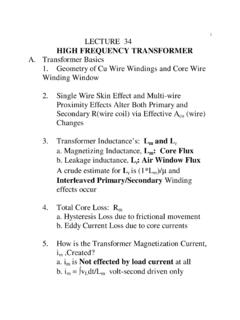Transcription of Wire Litz - Litz Wire
1 New England Electric wire CorporationLitzWireTechnical Information60 HZ to 1 KHZ28 AWG . KHZ to 10 KHZ30 AWG . KHZ to 20 KHZ33 AWG . KHZ to 50 KHZ36 AWG . KHZ to 100 KHZ38 AWG . KHZ to 200 KHZ40 AWG . KHZ to 350 KHZ42 AWG . KHZ to 850 KHZ44 AWG . KHZ to MHZ46 AWG . MHZ to MHZ48 AWG . Table 1 and other empirical data thefollowing table of recommended wire gauges for most litz constructions has 2 After the individual wire gauge has beendetermined and assuming that the litz constructionhas been designed such that each strand tends tooccupy all possible positions in the cable to ap-proximately the same extent, the ratio of resistance of an isolated litz conductor can bedetermined from the following 22 Resistance to Alternating CurrentResistance to Direct Curreent = H + K N DDGIO 2 Where: H = Resistance ratio of individualstrands when isolated(taken from Table 1 or 2)G = Eddy-currentbasis factorBy definition, the litz constructions coveredin this section are made with individually insulatedstrands.
2 Common magnet wire film insulationssuch as: polyvinylformal, polyurethane, polyure-thane/Nylon; solderable polyester, solderablepolyester/Nylon, polyester/polyamide-imide, andpolyimide are normally used. The outer insulationand the insulation on the component conductors, insome styles, may be servings or braids of Nylon,cotton, Nomex1, fiberglass or ceramic. Polyester,heat sealed polyester, polyimide, and PTFE tapewraps along with extrusions of most thermoplasticsare also available as outer insulation if the applica-tions dictate special requirements for voltagebreakdown or environmental DesignTypically, the design engineer requiringthe use of litz knows the operating frequency andRMS current required for the application. Since theprimary benefit of a litz conductor is the reductionof losses, the first consideration in any Litzdesign is the operating frequency.
3 The operatingfrequency not only influences the actual litz con-struction, but is also used to determine the individualwire of alternating-current resistance to direct-current resistance for an isolated solid round wire (H) in terms of a value (X) are shown value of X for copper wire is deter-mined by the following 1X D F MMHZ=0 : DM= wire diameter in milsFMHZ= Frequency in megahertz 2 litz WireNOM. COPPERRECM DWIRE GAUGEFREQUENCYSINGLESTRANDRAC/RDC H DC (MAX)1 DuPont Registered Trademark2 See Radio Engineers Handbook - Terman, pp. 30 - D F 4 3 Following is an example of thecalculations required to evaluate a Type 2 Litzconstruction consisting of 450 strands of40 AWG single-film polyurethane-coated wireoperating at 100 KHZ. This construction,designed with two bunching operations andone cabling operation, would be written5x3/30/40 (NEEWC uses x to indicate acabling operation and / to indicate abunching operation).
4 1. Calculate the resistance of theLitz construction using formula Calculate the to resistanceratio using formula The resistance is, therefore, x or ohms/1000 value of litz can easily be seen if theabove example is compared with a solid roundwire with equivalent cross sectional area, in diameter. Using the same operatingparameters, the resistance is ohms/1000 ft. However, the resistance ratioincreases to approximately making the ohms/1000 following tables list examples of Litzconstructions which can be manufactured byNew England wire Technologies. These arecategorized by operating frequency and byequivalent AWG size. Round, braided, andrectangular litz conductors are shown sepa-rately to provide the greatest possible selectionfor any design = Operating frequency in HZN = Number of strands in the cableDI= Diameter of the individualstrands over the copper in inchesDO= Diameter of the finished cableover the strands in inchesK = Constant depending on N, givenin the following tableN resistance of a litz conductor isrelated to the following parameters:1.
5 AWG of the individual Number of strands in the Factors relating to the increased lengthof the individual strands per unitlength of cable (take-up). For normalLitz constructions a increase resistance for every bunchingoperation and a increase resistance for every cablingoperation are approximately following formula derived from theseparameters for the resistance of any Litzconstruction is:Formula 3 R = R ()()1 : RDC= Resistance in ohms/1000 Maximum resistance ofthe individual strands (takenfrom Table 2)NB= Number of bunching opera-tionsNC= Number of cabling operationsNS= Number of individual strandsR = x450 = ohms/1000 DC21()()1 + 2 450 x = ()1 4 Round LitzLitz construction types 1 through 6 are alldesigned to be round and vary from a simple bunchof conductors (type 1) to complex designs utilizingmultiple cores and several manufacturing opera-tions (type 6).
6 The smaller constructions of litz types 1and 2 are typically used in High Q circuitry, suchas toroidal coils and transformers. The larger type2 and type 3 litz designs have greater currentcarrying capacities necesssary for high frequencypower supply, inverter and grounding applica-tions. Type 4, 5 and 6 litz constructions all utilizeat least one inert core and are used primarily intuning circuitry for high power radio Operating Frequency 60 HZ to 1 KHZ24476328S1 .. ,112728S1 . ,5881028S1 . , , , , , , , , , , (5x28/28)3/0171,5041, (5x24/28)4/0217,2381, (3x38/28)26300330S1 .. ,1001130S1 . , , , , , ,80016830 H2 . ,90025930 H2 . ,60026630 H2 . ,30041330 H2 . ,50052530 H2 . ,50066530 H2 . ,50080530 ,0001, ,0001, (5x45/30)3/0195,0001, (5x5x13/30)4/0252,0002, (5x3x28/30)Equivalent GaugeCircular Mil AreaNumber of StrandsStrand GaugeFilm CoatingConstruction TypeOuter InsulationNominal Outside DiameterNominal Current Resistance Litz12 (Inches)Recommended Operating Frequency 1 KHZ to 10 KHZR ecommended Operating Frequency 60 HZ to 1 KHZ1 & 2 See page 8 5 Equivalent GaugeCircular Mil AreaNumber of StrandsStrand GaugeFilm CoatingConstruction TypeOuter InsulationNominal Outside DiameterNominal Current Resistance Litz12 (Inches).
7 , , , , , , , , , ,5411, (5x44/33)190,7381, (3/5/20/33)1/0105,8612, (5/70/33)2/0136,1072, (5x3/30/33)3/0169,3773, (5x56/33)4/0211,7724, (5x3/20/33) 299,4355,94033S6 PVC (6(5/33/33)) 512,97210,17633S6 PVC (6(4x53/33)) 725,90414,40033S6 PVC (6(5x32/33)) 917,46218,20033S6 PVC (13(70/33)) 1,572,79231,20033S6 PVC (6(5/52/33))Recommended Operating Frequency 10 KHZ to 20 KHZ30100436S1 .. , , , , , , , ,2501, ,0001, ,5002, ,0003, (5x4x28/36)1/0108,0004, (5x3x32/36)2/0135,0005, (5x3x40/36)3/0171,0006, (5x3x38/36)4/0211,5008, (5x3x47/36)Recommended Operating Frequency 20 KHZ to 50 KHZ1 & 2 See page 8 6 Equivalent GaugeCircular Mil AreaNumber of StrandsStrand GaugeFilm CoatingConstruction TypeOuter InsulationNominal Outside DiameterNominal Current Resistance Litz12 (Inches) , , , , , , ,8001, ,4001, ,0002, ,2404, (5x3/46/38)184,0005, (5x5x35/38)1/0105,6006, (5x5x44/38)2/0136,0008, (5x5x34/38)3/0168,00010, (5x5x42/38)4/0211,20013, (5x5x44/38).
8 , , , , , , , , , (5x3/20/40)626, , (5x3/31/40)442, , (5x3/33/40)269, , (5x3/40/40)1/0 105, , (5x5x44/40)Recommended Operating Frequency 50 KHZ to 100 KHZR ecommended Operating Frequency 100 KHZ to 200 KHZ1 & 2 See page 8 7 Equivalent GaugeCircular Mil AreaNumber of StrandsStrand GaugeFilm CoatingConstruction TypeOuter InsulationNominal Outside DiameterNominal Current Resistance Litz12 (Inches) . , , , , , , , , (5x3/19/42)816, , (5x3/30/42)626, , (5x5/28/42)442, , (5x3/45/42)267, , (5x5/36/42)3816444S1 . , , , ,2001, ,6001, ,5002, ,8004, (5x5/28/44)Recommended Operating Frequency 200 KHZ to 350 KHZR ecommended Operating Frequency 350 KHZ to 850 KHZ1 & 2 See page 8 8 Equivalent GaugeCircular Mil AreaNumber of StrandsStrand GaugeFilm CoatingConstruction TypeOuter InsulationNominal Outside DiameterNominal Current Resistance Litz12 (Inches).
9 , , , , , , , , , , (5x5/29/46) . , , , , , , , , , (5x5/30/48)Recommended Operating Frequency MHZ to MHZR ecommended Operating Frequency 850 KHZ to MHZ1S = single-film coating thicknessH = heavy-film coating thickness2SN = single nylon servingDN = double nylon servingSNB = single nylon braidDNB = double nylon braidPVC = extruded polyvinylchloride 9 The type 7 braided litz constructions shownbelow are used primarily in high frequency ground-ing applications, or where special inductor designsrequire high aspect ratio conductors. We haveNominal ThicknessNominal WidthFilm CoatingStrand GaugeNumber of StrandsCircular Mil AreaEquivalent GaugeRectangular Braided Litz1 (Inches) (Inches)Recommended Operating Frequency 1 KHZ to 15 KHZ109, , , , , , , , , ,6001, ,6001, ,0001, ,6002, , , , , , , , ,4001, ,2001, ,0002, ,8004, only the most popular constructions andfrequency ranges.
10 Specific sizes utilizing almostany wire gauge are available for Braided Litz1 H = heavy-film coatingRecommended Operating Frequency 15 KHZ to 50 KHZN ominal ThicknessNominal WidthFilm CoatingStrand GaugeNumber of StrandsCircular Mil AreaEquivalent GaugeRectangular Compacted litz *Direct Current Resistance (Inches) (Inches) 10 Recommended Operating Frequency 400 HZ to 5 KHZThe following designs utilize monolithic conductors for the base following designs utilize monolithic conductors for the base following designs utilize monolithic conductors for the base following designs utilize monolithic conductors for the base following designs utilize monolithic conductors for the base group.*New England Patent 4439256 The rectangular compacted type 8 Litzconstructions listed in this section are designedwith copper densities from 60 to 75 percent of thecable s cross sectional area.




